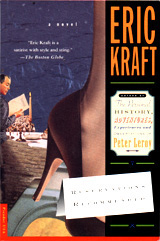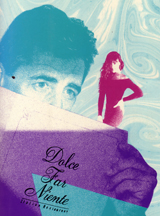
YOU CAN READ
THE FIRST HALF
OF THE BOOK
HERE,
ONLINE, ONSCREEN,
OR
YOU CAN PRINT IT
AND
READ IT IN BED,
OR,
FOR MAXIMUM PORTABILITY
AND CONVENIENCE
WHEN READING
ON THE BEACH
OR
IN THE TUB,
YOU CAN BUY THE
PICADOR USA
PAPERBACK EDITION AT
AMAZON.COM
OR
BARNES&NOBLE.COM.
|
|
  hat’s
the surprise?” Matthew asks. hat’s
the surprise?” Matthew asks.
Leila only winks. She’s not going to say anything about
it. “Try that drink,” she says. “See if it’s any good.”
He tries it. She’s been mixing martinis for
him nearly half her life, ever since her father taught her how, and Matthew’s
never had the heart to tell her that she uses too much vermouth.
“Excellent!” he says.
For one lightning moment, he thinks of making a
flirtatious remark, “You can mix my martinis anytime,” but it sounds obscene
to his mind’s ear, so he doesn’t say it—or anything else. Silence
hangs in the air for a moment, and he begins to feel awkward, so he decides
to go ahead and say it. “You can mix my martinis anytime,” he says,
but to show that it’s a joke, merely a joke, he says it in his W. C. Fields
voice. Too late, he realizes that if Leila doesn’t know who the hell
W. C. Fields was, then he must seem hideously goatish making such a suggestion
in such a voice. He seems to be getting deeper and deeper into trouble.
Maybe he should just go home.
“So,” he says, “you’re not going to tell me anything
about the surprise?”
“Nope. Can’t tell.” Shrugging, she makes
a girlish display of secrecy. This shrug, with her hands clasped
backward in front of her pubes, her arms stretched straight, her shoulders
hunched forward, makes her breasts balloon beneath the sweater. Is she
inviting me to tickle the secret out of her? His composure’s
slipping.
“Are you ready, Matthew?” calls Belinda from the
top of the stairs.
He takes another swallow of the drink, throws a
grin at Leila. “Now I am,” he says. “Shall I close my eyes?”
“No, no. I want to make an entrance.”
So it’s clothing, Matthew thinks. A dress,
probably, something daring that she wouldn’t ordinarily buy herself.
Good. Great. He has often wished she would wear something
slinky now and then, and this is the perfect night for it.
She steps into view at the top of the stairs wearing
a white fur coat. She stands there a moment, with her hands in the
pockets, striking a model’s pose, making cat’s eyes, sucking her cheeks
in. Then she begins walking down the the stairs, vamping.
The coat is startling. The skins are dyed
mink, sewn in such a way as to create the effect of vertical stripes, white
on white, and the collar and cuffs are ermine, softer and fluffier than
the mink, with the slightest hint of black at the tips of the hairs.
It’s a staggering, breathtaking coat.
“Wow,” says Matthew, and Leila giggles.
Belinda lets her face relax; it assumes a look that
says, “Haven’t I done something silly?”
“I got it on sale,” she says. “I’m not going
to tell you what it cost. I won’t even tell you what it would
have cost.”
Belinda takes Matthew’s arm, and they walk down
the steps. The cabdriver, who has been watching for them, gets out
of the cab—it would be fair to say that he leaps out of the cab—and
comes around to open the door. This has never happened to Matthew
before in his life. The driver begins sweeping at the seat with his
hand, and saying something in so low a voice that Matthew can’t be quite
sure what it is, but it sounds to him like “’Scuse me, ’scuse me.
Sorry, sorry. Dirty, dirty.” Matthew and Belinda get into the
cab, astonished. They look at each other, raise their eyebrows, struggle
to keep themselves from laughing.
“If he were wearing a cap,” Matthew whispers, “he
would have touched it. And if he weren’t bald, he would have tugged
his forelock.”
DOLCE FAR NIENTE is in the area where Belinda works, an area of spanking-new
office buildings housing young companies engaged in microelectronics, computer
software, genetic engineering, and any number of things involving lasers,
many of which are offensive. Matthew looks around. “This whole
section of town is all so new,” he says. “What was here before—I
mean, before all this?”
“Almost nothing. It was just a blank between
two highways.”
“Oh, yeah,” says Matthew, recalling. “The
only thing I remember about it is a lot of trucks. This is amazing.
Last year it was a parking lot, now it’s Houston.”
He has the uneasy feeling that in one of these handsome
buildings strange microscopic beings, the like of which have never been
seen on earth before, are at this moment engineering their escape from
a petri dish. Do genetic engineering outfits use petri dishes?
he wonders. Do they raise their manufactured microbes on agar,
or are agar and petri dishes hopelessly out of date?
“Do genetic engineering outfits grow their creatures
in agar?” he asks. “In petri dishes?”
“What?” says Belinda. “What on earth makes
you ask that?”
“I—” It seems too much to explain. “I
don’t know. I just wondered. Probably not. They’ve probably
engineered some new stuff to feed the newer stuff. Something bred
to be eaten. The perfect diet. Salvation of the planet.
Feed the starving. Allow more breeding.”
“Wow. Is it my coat that got you onto this?”
“What?”
“My coat made you bring up the subject of hunger?”
“What? No! Oh, no, not at all.
I love your coat. You look spectacular in it.”
THE RESTAURANT is in a building that used to be a service station for
the trucks that were kept here. It seems a small and frightened thing,
cowering in the presence of the towering. It has been decorated,
inside and out, at great expense, to look like a ruin. Here and there
are artful imitations of patches of peeling stucco, baring brick beneath.
One window has been painstakingly painted with some clear goo to make it
look as if there are bullet holes in it. Just inside the door a safe
stands crazily, one corner embedded in the floor as if it had fallen from
a great height. A section of one interior wall has been torn away
along a jagged line, the vacancy covered with glass, so that the plumbing
and wiring and heating ducts show. It reminds Matthew of his apartment.
Belinda’s coat has done something to her; she strides
into the restaurant with an assertiveness that Matthew has never seen in
her before.
Almost as soon as they have entered the room, a
voice from the bar calls, “Matthew!” Matthew turns at the sound of
his name and recognizes Harold, chief of the engineering department at
Manning & Rafter Toys, a man Matthew has some contact with nearly every
week, with whom he has worked closely on the development of a new toy,
a plastic press for molding bricks of sand. At this moment, taken
by surprise, he can remember this man only as Harold. “Hello!” Matthew
says brightly, far more warmly than he would if he were able to remember
Harold’s last name, very much as if he had been hoping that he might run
into Harold here. What the hell is his name? he asks himself.
It won’t come, won’t come at all. Harold’s motioning to him, making
large loops in the air with his hand, inviting him into the bar.
With Harold is his wife, whom Matthew has met several times. He cannot
remember even her first name. He decides not to bother with introductions;
he’ll say a quick hello, and he and Belinda will retreat into the dining
room.
Harold and his wife make ecstatic noises inspired by the coat.
Belinda obliges them by doing her model’s turn, making the coat flare as
she whirls.
“It’s a birthday present,” says Belinda.
“We’re here to celebrate,” says Matthew. He
begins to back away, taking Belinda by the arm.
“Well, so are we!” booms Harold. “It’s Gwen’s
birthday, too.” Gwen. Of course. “Let us buy you
a drink!”
Neither Matthew nor Belinda is good at saying no
in situations like this. Neither of them can say the truthful thing,
that they would rather go to their table and eat their dinner alone.
Instead they say, “Oh,” and, “Well,” and before they know it Harold has
summoned the bartender, who stands behind the bar and regards them expectantly,
waiting for their orders. What can they do? They order.
“So the coat is a gift from you, Matthew?” asks
Harold.
“No,” Matthew says. At first he’s surprised
that Harold would think he had given the coat to Belinda, but then he realizes
that of course it must look that way. It’s Belinda’s birthday, Matthew
brought her here to celebrate, and she’s wearing a new fur coat; therefore
Matthew must have given it to her. Logical thinking is the source
of so many errors. “Belinda bought it herself,” he explains.
“I gave her a necklace.” (“Necklace” is a little grand for the simple
gold chain Matthew gave her, a nice enough gift, but not one that made
much of a statement.)
“Oh, yes,” says Belinda, “Matthew gave me a beautiful
chain.” She throws the coat open, spreading her arms wide, and there
is the chain, gleaming against more of Belinda’s chest than Matthew has
ever before seen displayed in a public setting. He is astonished,
but he is very pleased with himself to find that he does not say “Wow,”
or “Gosh.”
“Wow,” says Harold. For an instant there’s
the strong possibility that he may reach out and hook his finger through
the bottom curve of the chain, which lies almost out of sight between Belinda’s
breasts, but he thinks better of it, and to ensure that he doesn’t lose
control of his hands, he puts them in his pockets. “That’s lovely,”
he says. “Really lovely.”
“Let me check the coat,” Matthew says. He
realizes that he has said “the coat,” not “your coat.” He slips it
off Belinda’s shoulders and is startled to discover that her dress, which
has so little front, has no back. Black crepe falls from Belinda’s
shoulders in languid folds to an arc below her waist. Catenary
arc, he thinks, and because he has little control left he says, at
last, “Wow.”
He checks the coat. The young woman who is
both coat-check girl and greeter takes it from him as if it were a child
and smiles in a way that seems to suggest that if there are fur coats like
this one to be had, she might be interested in seeing more of Matthew.
He is, he realizes, almost certainly a victim of wishful thinking in so
interpreting that smile, but he gets a nice lift from it anyway. |
|
 |



 Here
are a couple of swell ideas from Eric Kraft's vivacious publicist, Candi
Lee Manning:
Here
are a couple of swell ideas from Eric Kraft's vivacious publicist, Candi
Lee Manning:
